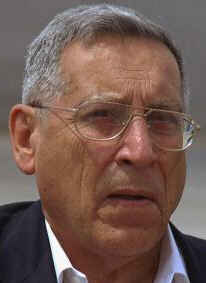 Deaths
which occurred on a 17 October:
^top^ Deaths
which occurred on a 17 October:
^top^
2002 Eight Palestinians, in the afternoon, shot by Israeli
tanks in Rafah, Gaza Strip. Two women, aged 72 and 32, an 11-year-old boy
and an 8-year-old girl were among the dead, killed when tank shells slammed
into their houses. Two other fatalities were a 27-year-old man who owned
a grocery store and a 45-year-old man.
2002 Seven persons by terrorist bomb at noon (04:00 UT)
near the produce section in the Shop-o-Rama mall, in Zamboanga, Philippines.
143 are injured, 20 of them critically. Half-an-hour later another bomb
explodes in a nearby store. Two other terrorist bombs are found unexploded
in the area.
2001 Rehavam Zeevi, 75 [< photo], by three
bullets in the head and face, in a hallway of the Hyatt Hotel in Jerusalem,
at about 07:00. He was the extremist right-wing Tourism Minister who advocated
the ouster of all Palestinians from the West Bank and Gaza Strip. Two days
earlier he had announced his resignation (effective today) in protest for
a slight easing of restrictions on the movements of Palestinians. The assassination
is the work of the Popular Front for the Liberation of Palestine, in retaliation
for the 27 August 2001 assassination of its leader Abu Ali Mustafa Zibri
by an Israeli rocket attack on his office in Ramallah. Zeevi always refused
to have bodyguards, usually carried his own weapon (though not when he was
shot), and ostentatiously would stay in the Arab part of Jerusalem. Israel
would exact severe reprisals againt the Palestinians and demand that Palestinian
president Arafat order the arrest and extradition to Israel of the killers.
Confined since 29 March 2002 to a few rooms in his Ramallah headquarters
by a circle of Israeli tanks and troops, Arafat would order a trial, starting
on 22 April 2002, with security officers with no legal experience acting
as judges and lawyers. On 25 April Arafat would confirm the prison
sentences, without right of appeal, of gunman Hamdi Quran to 18 years, his
lookout Basel Al-Asmar to 12 years, getaway driver Majdi Rimawi to 8 years,
and Ahead Gholmy to 1 year for having knowledge of the plot but not informing
Palestinian authorities. The Sharon government of Israel is not mollified.
Under 1994 interim peace accords (which Israel violates perhaps even more
than the Palestinians), Palestinians are to extradite suspects to Israel
-- unless they put them on trial in Palestinian courts. Israel has said
it would not lift its siege on Arafat's compound until the wanted Palestinians
hiding inside, including the suspected assassins, were turned over and brought
to Israeli justice.
2000 Farid Musa ‘Issa Nasasreh, 28, Palestinian killed by gunfire
from Israeli settlers, in Bet Furiq, Nablus district, West Bank.
1994 Dmitry Kholodov, 27, investigative reporter for Moskovsky
Komsomolets, by bomb he unknowingly picks up at a Moscow train
station in a briefcase which an anonymous caller just told him was there
for him with information on corruption in Russian military intelligence.
Authorities would take until 09 November 2000 to bring to trial for the
crime the former head of the Russian paratrooper intelligence service, Colonel
Pavel Popovskikh, his four subordinates, and a deputy head of a private
security firm. On 26 June 2002 a military court would outrageously acquit
the obviously guilty six. Pavel Grachev, defense minister at the time of
the murder, had ordered the killing, but he is not even indicted. During
questioning, Grachev told investigators that he had merely asked the officers
to “sort it out” with Kholodov.
1991 Un teniente en uno de tres atentados con coche bomba de ETA
(Euskadi Ta Askatasuna) que se suceden en Madrid y causan graves heridas
a un comandante y a dos civiles.
1990 Ralph Abernathy civil rights leader
1989: 67 persons in San Francisco earthquake
^top^
The deadliest US earthquake since 1906 strikes the San Francisco Bay area
in California. The quake, measuring 7.1 on the Richter scale, is witnessed
on live television by millions of people watching the introduction to the
third game of the 86th World Series of baseball between the San Francisco
Giants and the Oakland Athletics, held at Candlestick Park in San Francisco.
The tremor hits moments before the game, which is canceled, and sportscasters
perform the duties of news anchors as they report on the resulting pandemonium
in the stadium. The earthquake killed a total of sixty-seven people, while
over three thousand others were injured and causing $7 billion worth of
damage to infrastructure and more than 100'000 buildings.
—
Un terremoto sacude el norte de California y causa un centenar de muertos
y cuantiosos daños materiales en la ciudad de San
Francisco.
1983 Raymond Aron, sociólogo y ensayista francés.
1978 Cox,
mathematician
1977: 3 of 4 hijackers, as West German
commandos storm hijacked Lufthansa in Mogadishu, Somalia freeing all 86
hostages.
1963 Jacques
Hadamard, 98, mathematician
1962 Natalia Sergeevna
Gontcharova, innovative Russian painter, sculptor, and stage designer,
born 04 June 1881. — MORE
ON GONTCHAROVA AT ART “4” OCTOBER
with links to images.
1961 Over 200 Algerians massacred
in Paris ^top^
Paris police massacre over two hundred
Algerians protesting against police oppression and the curfew imposed
against their community in Paris. In the three months preceding the
protest, over thirty Paris policemen had been killed by the Algerian
National Liberation Front (FLN), a group that employed terrorist tactics
to fight French colonial rule in Algeria.
In response to the killings, Paris police chief Maurice Papon ordered
a violent crackdown on Paris' Algerian community, explaining to officers
that they would be protected against any charges of excessive violence.
Police searched the Algerian ghettos for FLN members, indiscriminately
killing a number of innocent Algerians before turning their guns on
a large group of protestors gathered near the Seine River. The next
day, the police release an official death toll of three dead and sixty-seven
wounded, a figure generally disregarded by witnesses who observe bodies
littering the area and floating in the Seine.
In 1997, after it is revealed that Maurice Papon collaborated with
the Nazis during the German occupation of France, sealed police archives
detailing the massacre are made public by the French government. During
Nazi occupation, Paton, a senior official in the Vichy regime, assisted
in the deportation of French Jews to death camps, a wartime role he
successfully hid for over fifty years while serving as the Paris police
chief and later as a cabinet minister.
Paris police massacre more than 200 Algerians marching in the city
in support of peace talks to end their country's war of independence
against France. Tensions were running high in Paris at the time, with
Algerian terrorists setting off bombs in the French capital and randomly
killing Paris policemen. In response, Paris police chief Maurice Papon
ordered a crackdown on Paris' Algerian community, explaining to his
officers that they would be protected against any charges of excessive
violence. Police searched the Algerian ghettos for terrorists, killing
a number of innocent Algerians before turning their guns on a group
of 30'000 protesters who defied a curfew and gathered near the Seine
River on the night of 17 October. The next day, the police released
an official death toll of three dead and 67 wounded, a figure generally
disregarded by witnesses who observed bodies littering the area and
floating in the Seine.
On 06
May 1981, Le Canard Enchaîné revealed that Maurice
Papon had collaborated with the Nazis during the German occupation
of France, and he was forced to resign his three-year-old position
as budget minister in the cabinet. Papon, a former official in France's
Vichy regime, was suspected of aiding in the deportation of hundreds
of French Jews to the Nazi death camps.
Papon
was first indicted for crimes against humanity on 19 January 1983,
but managed to delay the start of his
trial until 08 October 1997. At its conclusion on 02 April 1998
(it was the longest trial in French history) he was found guilty of
''complicity in crimes against humanity'' and sentenced to 10 years
in prison. During his trial, documents about the 1961 massacre in
Paris surfaced, acknowledging that Papon's policemen had killed many
more Algerians than previously admitted. But he was not tried for
this crime, only for those against the Jews,
On 18 September 2002, Papon, then 92 (he was born on 03 September
1910), would be released from prison on the grounds that his health
was "incompatible with his remaining in detention." |
1952 Vessiot,
mathematician
1944 Rufino Blanco Fombona, escritor
venezolano.
1941: 11 US sailors, as US destroyer
Kearney is torpedoed by a German U-boat
^top^
Though the US are still neutral, a German submarine torpedoes the
US destroyer Kearney 560 km southwest of Iceland, killing
eleven crew members and seriously wounding two. The Kearney, the first
destroyer attacked by a German submarine, sustains heavy damage but
manages to stay afloat under the command of Lieutenant Colonel Anthony
Danis. Two days later, the Kearney arrives safely in Iceland.
|
1937 Morley,
mathematician
1934 Santiago Ramón y Cajal, médico
español. Premio Nobel en 1906.
— MORE
1928 Sir Francis Bernard Dicksee, English
painter and illustrator born on 27 November 1853. — MORE
ON DICKSEE AT ART “4” OCTOBER
with links to images.
1919 Henry Brodribb Irving,
author. HENRY IRVING ONLINE: A
Book of Remarkable Criminals
1918 Luigi Nono,
Italian artist born on 08 December 1850. — [Was his personality affected
because, as a child, he was always told by his mother: “Luigi, no no!”
and when she saw his first picture, she said: “That is a Nono!”?]
[Is this also why I cannot find on the Internet any reproduction of his
artwork?]
1913: 28 persons, as Zeppelin LII explodes
over London
| 1910 Julia Ward
Howe, 91, composer (Battle Hymn of the Republic,
below) ^top^ |
Mine eyes have seen the glory of the coming of the
Lord
He is trampling out the vintage where the grapes of wrath are stored,
He has loosed the fateful lightening of His terrible swift sword
His truth is marching on.
(Chorus) Glory! Glory!
Hallelujah!
Glory! Glory! Hallelujah!
Glory! Glory! Hallelujah!
His truth is marching on.
I have seen Him in the watch-fires of a hundred circling
camps
They have builded Him an altar in the evening dews and damps
l can read His righteous sentence by the dim and flaring lamps
His day is marching on.
(Chorus)
I have read a fiery gospel writ in burnish`d rows of steel,
"As ye deal with my contemners, So with you my grace shall deal;"
Let the Hero, born of woman, crush the serpent with his heel
Since God is marching on.
(Chorus) |
He has sounded forth the trumpet that shall never call
retreat
He is sifting out the hearts of men before His judgment-seat
Oh, be swift, my soul, to answer Him! be jubilant, my feet!
Our God is marching on.
(Chorus)
He has sounded form the trumpet that shall never call retreat
He is sifting out the hearts of men before His judgment-seat
Oh, be swift, my soul, to answer Him! be jubilant, my feet!
Our God is marching on.
(Chorus)
ln the beauty of the lilies Christ was born across the sea,
With a glory in His bosom that transfigures you and me:
As He died to make men holy, let us die to make men free,
While God is marching on.
(Chorus)
In the beauty of the lilies Christ was borne across the sea
With a glory in His being that transfigures you and me,
As He died to make men holy, let us live to make men free,
His truth is marching on! -- (Chorus) |
1910 William Vaughn Moody, poet. MOODY ONLINE: Poems
, Poems
1897 Charles Anderson Dana, editor of The
United States Illustrated: in Views of City and Country
1894 Three lynchers killed by Ohio national guard while
rescuing a black man.
1892 Paul Peel, Canadian painter,
active also in France, specialized in children, born on 07 November 1860.
— more with link.
1891 James Parton, author. PARTON ONLINE: Famous
Americans of Recent Times
1887 Gustav
Robert Kirchhoff, mathematician and physicist discoverer of
the laws of spectroscopy.
1859 Two of John Brown's sons
and 10 others, in raid on Harpers Ferry
^top^
At midnight, the radical abolitionist John
Brown leads a group of twenty-one followers, calling themselves
the "Provisional Army of the United States," on a raid of the Federal
arsenal of Harpers Ferry, located in present-day West Virginia.
Brown, born in Connecticut on 9 May
1800, first became militant during the mid-1850s, when as a leader
of the Free State forces in the territory of Kansas he fought pro-slavery
settlers, contributing to the sharply divided territory's popular
designation as "Bleeding Kansas.” For example on 24 May 1856
he led the "Pottawatomie Massacre" by John Brown's gang
In retaliation for the sacking of the abolitionist town of Lawrence,
Kansas, by pro-slavery forces, militant abolitionist John Brown led
a raid against a pro-slavery settlement along Pottawatomie Creek.
Brown’s small force, which included four of his sons, fell on the
settlement at night and massacred five men, including two teenage
boys.
Although they owned no
slaves, Brown deemed the Pottawatomie settlers deserving of capital
punishment because they had supported the Missouri faction in the
dispute over the Kansas territorial government. Trouble in the territory
began with the signing of the 1854 Kansas-Nebraska Act by President
Franklin Pierce. The act stipulated that settlers in the newly created
territories of Nebraska and Kansas would decide by popular vote whether
their territory would be free or slave. In early 1855, Kansas’ first
election proved a violent affair as over 5000 so-called "Border Ruffians"
invaded the territory from western Missouri and forced the election
of a pro-slavery legislature.
To prevent further bloodshed, Andrew H. Reeder, appointed territorial
governor by President Pierce, reluctantly approved the election. A
few months later, the Kansas Free State forces were formed, armed
by supporters in the North and featuring the leadership of John Brown.
In 1859, Brown left "Bleeding Kansas," as it had become popularly
known, and settled on a more ambitious plan.
Achieving
only moderate success against slavery on the Kansas frontier, Brown
settled on a more ambitious plan in 1859. With a group of racially
mixed followers, Brown set out to Harpers Ferry, intending to seize
the arsenal of weapons and retreat to the Appalachian Mountains of
Maryland and Virginia, where they would establish an abolitionist
republic of liberated slaves and abolitionist whites. Their republic
would form a guerilla army to fight slaveholders and ignite slave
insurrections, and its population would grow exponentially with the
influx of liberated and fugitive slaves.
At Harpers Ferry, Brown's well-trained unit is initially successful--in
the space of two hours, the raiders seize the Shenandoah Bridge, Hall's
Rifle Works, and the Federal arsenal, barricade the bridge across
the Potomac, cut telegraph wires, and take some 60 hostages. But at
01:20, Brown's plans begin to deteriorate when his raiders stop a
Baltimore-bound train, and then allow it to pass through.
News of the raid spreads quickly and militia companies from Maryland
and Virginia arrive the next day, killing or capturing several raiders.
On 18 October, US Marines commanded by Colonel Robert E. Lee and Lieutenant
J. E. B. Stuart, both of whom are destined to become famous Confederate
generals, recapture the Federal arsenal, taking John Brown and several
other raiders alive.
John Brown
was tried by the Commonwealth of Virginia for treason, murder and
inciting slaves to rebellion. On 02 November, Brown is sentenced to
death by hanging, and on the day of his execution, 02 December 1859,
ten months before the outbreak of the Civil War, he prophetically
writes, "The crimes of this guilty land will never be purged away
but with blood.”
Abolitionist
Thoreau wrote A
Plea for Captain John Brown , A
Plea for Captain John Brown
Walter
Hawkins wrote Old
John Brown: The Man Whose Soul is Marching On
Stephen
Vincent Benet wrote John Brown's Body |
1849 Fréderic Chopin, 39, Composer and pianist,
in Paris, of tuberculosis.
1823 Johannes-Christiaan Janson,
Dutch artist born in 1763. —
1817 West,
mathematician
| 1806 Jean-Jacques Dessalines,
48, killed trying to put down a revolt under the Mulatto leader Alexandre
Sabès Pétion. Dessalines, after proclaiming on 01 January 1804 the
independence of Hispaniola under the name Haiti, and, in September
1804, himself as emperor Jacques I, discriminated against and massacred
Whites and Mulattos. |
1780 Bernardo Bellotto, Italian artist born in 1721 or
1724. — MORE
ON BELLOTTO AT ART “4” OCTOBER
with links to images.
1757 René Antoine Ferchault de Réaumur,
físico y naturalista francés.
1638 Jakob Isaaksz Swanenburgh,
Dutch artist born in 1571.
1586 Philip Sidney,
author. SIDNEY ONLINE: Astrophel
and Stella, The
Defence of Poesie, A
Defence of Poesie and Poems, Selected
Works
1533 (before 18 Oct) Jacob Corneliszoon van Oostsanen d'Amsterdam,
Dutch painter born before 1477. — links
to images.
0532 Boniface II, Pope
^top^
Before his death in September 530,
Pope
Saint Felix IV, fearing a contest for the papacy between Roman
and Gothic factions, in the presence of several of his clergy and
of a number of Roman Senators and patricians, had proclaimed his aged
archdeacon Boniface as his successor and threatened with excommunication
those refusing to recognize and obey Boniface as validly chosen pope.
On Felix's death Boniface assumed
succession as Boniface
II, but 60 out of perhaps about 70 Roman priests refused to accept
him and elected Dioscorus. They feared the undue influence in papal
affairs of the Ostrogothic King Athalaric, whose grandfather, Theodoric
I, had helped to elect Pope Felix IV, a circumstance rendering more
odious the latter's nomination of Boniface. Originally a deacon of
the Church of Alexandria, Dioscorus
was adopted into the ranks of the Roman clergy, and by his commanding
abilities soon acquired considerable influence in the Church of Rome.
Under Pope Symmachus he was sent to Ravenna on an important mission
to Theodoric the Goth, and later, under Pope Hormisdas, served with
great distinction as papal apocrisiarius, or legate, to the court
of Justinian at Constantinople. During the pontificate of Felix IV
he became the recognized head of the Byzantine party — a party
in Rome which opposed the growing influence and power of a rival faction,
the Gothic, to which the pope inclined.
Both popes were consecrated on 22 September 530, Boniface in the Basilica
of Julius, and Dioscorus in the Lateran. The Roman Church was thus
involved in the seventh anti-papal
schism. Fortunately it endured but twenty-two days, for Dioscorus
died on 14 October 530, leaving Boniface in possession. The previous
antipopes were Hippolytus
(3rd century), Novatian
(251), Felix
II (355-365), Ursicinus or Ursinus (366-367, against pope
Sant Damasus I), Eulalius (418-419, against pope
Saint Boniface I), and Laurentius (498-501, against pope
Saint Symmachus)
In December
530 Boniface II soon convened a Roman synod and presented a decree
anathematizing his late rival to which he secured the signatures of
the priests who had been Dioscorus's partisans Each of these expressed
regret for their participation in the irregular election and pledged
future obedience. Boniface reconciled many by his mild, conciliatory
administration; but some resentment remained, for he seems not to
have been tendered a formal election by those who, despite their submission,
had impugned the validly of his nomination; and five years later a
pope of their choice, Saint
Agapetus I, solemnly burned the anathema against Dioscorus. |
|
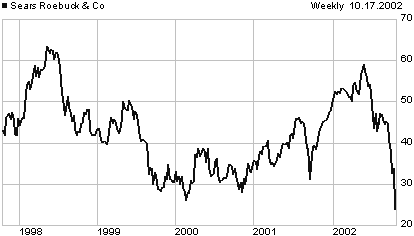 On
a 17 October:
On
a 17 October: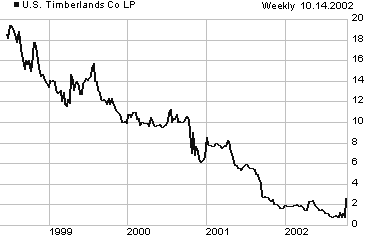 They had traded as low as $0.55 as recently as 09 October 2002, after
dropping from a high of $2.56 on 29 April 2002. They had started trading
at $18.13 on 22 June 1998 and after peaking at $19.50 on 06 July 1998
had been in a downtrend that was threatening to get them delisted. [5~year
price chart >]
They had traded as low as $0.55 as recently as 09 October 2002, after
dropping from a high of $2.56 on 29 April 2002. They had started trading
at $18.13 on 22 June 1998 and after peaking at $19.50 on 06 July 1998
had been in a downtrend that was threatening to get them delisted. [5~year
price chart >]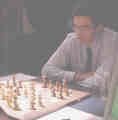 2002
Human world chess champion Vladimir Kramnik, with Black, and computer
program Deep Fritz, with White, play to a draw the 7th of the 8 games
in their match of 04,
06,
08,
10,
13,
15,
17,
and 19
October 2002, remaining tied, now 3.5 to 3.5. —
1. d4 – Nf6 / 2. c4 – e6 / 3. Nf3 – b6 / 4. g3 – Bb7
/ 5. Bg2 – Be7 / 6. 0-0 – 0-0 7. Nc3 – Ne4 8. Qc2 –
Nxc3 / 9. Qxc3 – c5 / 10. Rd1 – d6 / 11. b3 – Bf6 / 12.
Bb2 – Qe7 / 13. Qc2 – Nc6 / 14. e4 – e5 / 15.d5 –
Nd4 / 16. Bxd4 – cxd4 / 17. Bh3 – g6 / 18. a4 – a5 / 19.
Rab1 – Ba6 / 20. Re1 – Kh8 / 21. Kg2 – Bg7 / 22. Qd3 –
Rae8 / 23. Nd2 – Bh6 / 24. f4 – Qc7 / 25. Rf1 – Kg8 / 26.
Rbe1 – Qd8 / 27.Kg1 – Bb7 / 28. Re2 – Ba6 draw [final
position below]
2002
Human world chess champion Vladimir Kramnik, with Black, and computer
program Deep Fritz, with White, play to a draw the 7th of the 8 games
in their match of 04,
06,
08,
10,
13,
15,
17,
and 19
October 2002, remaining tied, now 3.5 to 3.5. —
1. d4 – Nf6 / 2. c4 – e6 / 3. Nf3 – b6 / 4. g3 – Bb7
/ 5. Bg2 – Be7 / 6. 0-0 – 0-0 7. Nc3 – Ne4 8. Qc2 –
Nxc3 / 9. Qxc3 – c5 / 10. Rd1 – d6 / 11. b3 – Bf6 / 12.
Bb2 – Qe7 / 13. Qc2 – Nc6 / 14. e4 – e5 / 15.d5 –
Nd4 / 16. Bxd4 – cxd4 / 17. Bh3 – g6 / 18. a4 – a5 / 19.
Rab1 – Ba6 / 20. Re1 – Kh8 / 21. Kg2 – Bg7 / 22. Qd3 –
Rae8 / 23. Nd2 – Bh6 / 24. f4 – Qc7 / 25. Rf1 – Kg8 / 26.
Rbe1 – Qd8 / 27.Kg1 – Bb7 / 28. Re2 – Ba6 draw [final
position below]
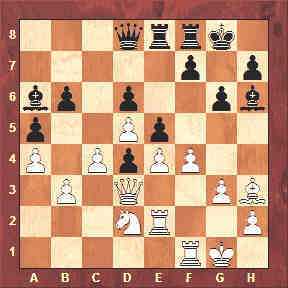
 Deaths
Deaths